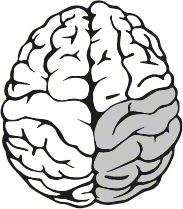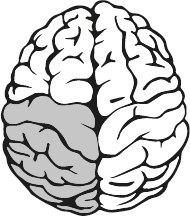Emotional intelligence and the brain
The human brain is the control centre for our entire nervous system. It continuously receives signals from the body’s primary sensory inputs such as sight, sound, touch, smell and taste. These inputs get translated via the neocortex into signals or thoughts.
Although many of the processes that keep our bodies functioning are not ‘thoughts’ as such, they are a combination of electrical and chemical impulses delivered via our central nervous and limbic (emotional) systems which provide the stimulus to various muscle groups throughout our bodies.
The cerebrum is the newest frontal part of our brain, in evolutionary terms, and happens to be the most significant part of our modern-day intellectual brain, because it is here that things like perception, imagination, thought, judgement and decision occur.
There is a band of nerve fibres called the corpus callosum which links the left and right halves of the brain; its primary role is to enable the two halves of our brain to communicate with each other. Interestingly, the right-hand side of our brain operates the left-hand side of our body and vice versa.
The cerebral cortex is further divided by the central sulcus, which separates the front and back parts of our brain and, most conveniently for us, it helps us to describe four separate regions or cortexes.
Based on the research of Dr Iain McGilchrist (Fellow of the Royal College of Psychiatrists and former Research Fellow in Neuroimaging at the Johns Hopkins Hospital in Baltimore), the following images outline a summary of the functions we understand that each of these cortexes serves.
The front right cortex examines abstract patterns. It generates and manipulates internal images of complex spatial information to identify trends and to develop evolving needs. It is this area that governs imagination.

The right rear cortex processes harmonic information about relationships, differentiating between tonal qualities or pitches in someone’s voice, body positions and various facial expressions, to distinguish between harmonious and discordant relationships.

The front left cortex examines structures with precision and accuracy, identifying any weaknesses or malfunctions; it evaluates and solves problems to determine if the fault is repairable.

The left rear cortex sequentially processes information, it learns and performs a procedure or routine to achieve results, generally involving facts, statistics or objects rather than people.

When we consider these cortexes on both left and right sides, we gain a clearer understanding of why we might determine a person as being more right-brained (creative or caring) or left-brained (analytical or processing).
These images also help us to identify how some of these combined functions shape our preferences and, subsequently, inform how we might respond in certain situations.
For example, if we are highly imaginative, like solving problems, although we may dislike order and structure, and possibly are not too worried about relationships, there is a high possibility that we will tend to use more of the frontal two cortexes.
If, however, we prefer people to problems and using creativity rather than statistics (emotions and imagination, to rational and analytical thought), the likelihood is that we will be using more of the two right-side cortexes.
If we are entirely devoid of any creativity, are not too worried about other people and like to get results using a consistent and methodical approach, it is more likely that we have an analytical preference and use the front left cortex.
Do bear in mind that we will also still be using all the other parts of our brain as well; this is more about identifying how our unique preferences combine to explain how we behave during work, rest and play.
A fascinating way to help us determine whether another person prefers using more of the right or left part of their brain is to consider which hand is their more predominant when they are communicating with us.
For example, we might notice that a person who prefers being more analytical will tend to use their right hand (if they are right-handed). Particularly, when they are explaining something, we will also see that their gestures are likely to be more focused, succinct or pronounced towards a particular subject or point of view.
They may well be pointing their index finger as they speak or moving a flat hand up and down as they detail specific points. Additionally, their speech patterns will tend towards mirroring their gestures and appear to sound shorter, more concise and a lot more focused.
Whereas, when we are communicating with a person who is using their more creative side, their preference is to use their left hand (if they are right-handed), their gestures will be softer, relaxed, open and a lot more fluid.
Their speech patterns will also reflect this and tend towards using more open, descriptive words, which help them to colour and shape their dialogue.
So, what is the relevance here for being more emotionally intelligent?
The simple answer is that the more we are aware of and understand other peoples’ preferences, the more we can adapt our preferences to suit them.
Ensuring that our communication becomes more in tune with their way of thinking, and not necessarily with our own, enables faster understanding of our messages as well as gaining a vital emotional link with them as unique individuals.
A great way of demonstrating this approach is to tune into our communication style and notice our preferences, the pattern of our speech, the type of words we use and the hand we prefer to use when we are talking.
It might, at first, feel a little awkward if we restrict our preferred hand from moving and allow the other hand to operate for us instead. However, what we will undoubtedly discover is that our whole communication style will change and, depending on the situation, quite often for the better!
For example, when I have worked with people to help them improve their presentation skills, I have suggested that they, quite literally, ‘swap hands’, allowing the opposite hand and the opposite side of their brain (usually the more creative and relationship-orientated part) to take more of an active role in their communication.
You might want to try this out for yourself by simply changing the hand that usually holds a pen while you are talking with another person. I often do this when I am presenting to a large group of people. Ensuring that the open, relationship-orientated and the more engaging side of my brain has preference at that particular time and, more often than not, it completely changes, for the better, the quality of the communication I am having.
This phenomenon might well be the reason why so many weather presenters on television appear always to be positioned to the left of the weather maps, allowing their left hand to gesture towards the weatherboard and not their right. Thus, ensuring that they engage more with their audience rather than appearing to talk directly at or to them.
It might also be why so many politicians appear trained to adjust their hands to more open gestures; rather than allowing their fingers to point at us. Which, by the way, might also remove any perception the audience will form of the politician ‘telling’ or ‘talking at people’ when they are being interviewed live on camera!
Before we become too embroiled in the differences between left- and right-handed gestures, we must take note that these may well be opposite for some entirely left-handed people, where the opposite side of the brain will also be affected. In other words, creativity and relationships would be on their left half and analytical and processing on their right half.
I am sure you are getting the idea, so take some time now to think about your preferences and, potentially, the impact that these have on the way you prefer to think and how that influences the way you currently engage with other people.
Activity
Think about which parts of your brain you prefer to use the most and, then, consider how this inhibits or helps you across the many different aspects of your life.
Some initial questions to get you started:
- How creative are you at work or home, and how does this preference help or hinder you when you are solving problems?
- How comfortably do you relate to new people, and what effect does this have on your work or home life?
- How often might you prefer to keep referring back to facts and information, and what impact does this have on others?
- How comfortable are you at solving complex issues or problems, and how might this preference impact the way you deal with people?
I hope that you are now beginning to understand that it is all down to our personal preferences. And, those preferences relate to the choices we make every day. Unless you have some profound neurological condition, which I doubt, seeing as you are reading this book, you have precisely the same mental capability as anyone else.
Emotional or intellectual intelligence is not purely genetic; they both have to evolve through learning and practice. What this fundamental principle means is that it is down to the choices we make that determines the level of our emotional and intellectual intelligence that we use at any particular point in time.
I have outlined, over the next few pages, some of the brain functions that attribute directly to the choices we can make, especially around being emotionally intelligent.
